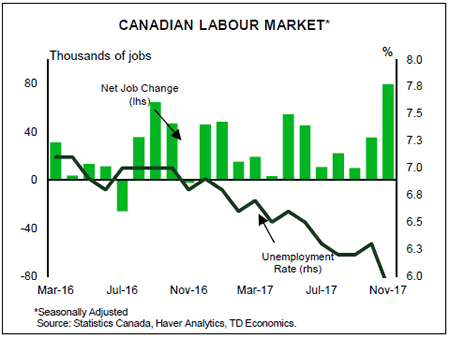U.S. Highlights
- The Tax Cuts and Jobs Act was passed by Congress and signed by the President this week.
- The U.S. economy continues to show signs of strong momentum heading into 2018. Housing activity is recovering nicely from late summer hurricane-related disruptions, and consumer spending is on pace to expand at a 3.0% annualized pace this quarter.
- Looking ahead into 2018, political events in Europe are likely to continue to dominate headlines in the New Year.
Canadian Highlights
- Canadian economy bulls got some early Christmas presents, with several robust data reports lifting the loonie, supporting equities and leading to a government bond sell-off, with only one lump of coal to be found.
- Retail and wholesale trade reports were both very strong, boding well for consumption which we now project will grow by over 3% in the fourth-quarter. Still, a weak monthly GDP report, indicating that economic activity remained flat in October, suggests that GDP growth is likely to come in closer to the mid-2% mark.
- The relatively robust data, alongside a CPI report which indicated that inflationary pressures are building, has boosted the chances of a January rate hike. Still, we remain of the view that a move in March is the more likely scenario.
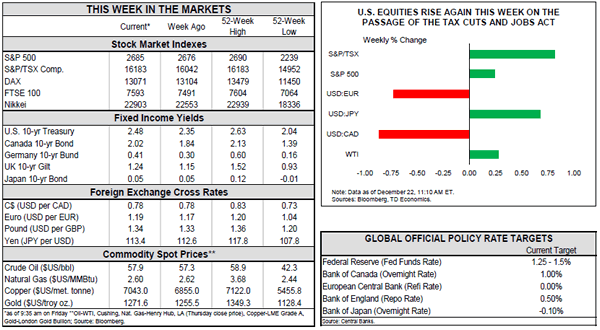
U.S. – Visions of Tax Cuts Dancing in our Heads
From an economist’s perspective, it’s difficult to be disappointed with how 2017 turned out. After a bumpy start to the year – courtesy of a phenomenon coined ‘residual seasonality’ – growth in the U.S. held at a 3.0% pace for the remainder of 2017, well above trend estimates at just under 2.0%. Moreover, stronger-than-expected growth became a global theme, as G7 economies broadly surprised to the upside. Since the middle of 2016, Canada, the U.S., the Euro Area, and even Japan reported growth well above trend estimates. Strong growth spurred central bank action, with the Fed raising rates thrice, but no longer alone in removing stimulus. The Bank of Canada raised rates twice in late summer, while the Bank of England followed with a rate hike in November. Not to be left out, the ECB followed through with earlier communication of reducing their pace of monthly asset purchases, halving them to €30 billion starting next month.
The hot streak for the U.S. economy looks set to continue heading into 2018. This week’s indicators revealed a housing market rebounding nicely from hurricane-related setbacks, with both housing starts and existing home sales rising above consensus expectations in November. Consumer spending is also holding up, rising 0.4% in November (month-on-month, in real terms) after flat-lining in October. Moreover, with strong employment and decent income growth and a tax cut to boot, consumer spending looks set to advance about 3.0% (annualized) this quarter.
With the U.S. economy running hot, additional stimulus in the form of tax cuts seems unnecessary. But, after months of debate, Congress this week approved tax cuts that will leave American households and businesses with more money to spend for the next five to ten years. As covered in our note, we anticipate that the plan should help to stimulate economic activity in the medium-term, but at the expense of higher debt that may necessitate future cuts to entitlement spending, or higher taxes. Nevertheless, U.S. stock markets rallied in response to the news, while bonds markets sold off sending yields a touch higher on the week.
Heightened levels of economic optimism are to be expected with growth running hot globally. However, geopolitical events are stewing in the background, threatening to knock the current expansion off course. Looking ahead into 2018, concerns about North Korea’s military ambitions will remain, as will tensions between the major powers in the Middle East. And, like a broken record, political events in Europe remain on the radar. Phase two of Brexit negotiations are set to begin early in the New Year, and EU officials this week stated that they will have a EU-Canada style trade agreement in their pocket in case negotiations fail to make material progress by summer. Moreover, results from this week’s Catalonian election shows strong support for independence-minded parties, suggesting the potential for economic uncertainty to linger in Spain, the Euro Area’s fourth largest economy.
Add elections in Italy, Sweden and Eastern Europe next year, and it’s clear European politics will dominate headlines for another year. We hope that once again strong economic growth manages to trump uncertainty in 2018.
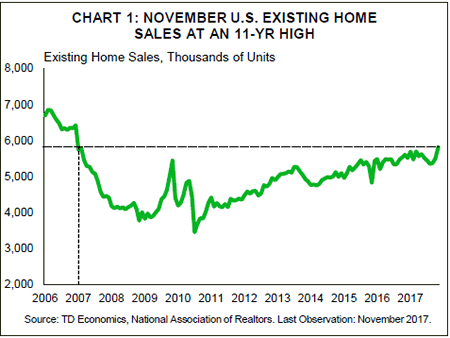
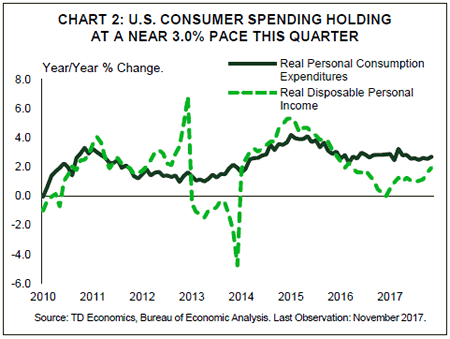
Canada – GDP Report Stands Out as the Only Lump of Coal
‘Twas the week before Christmas, when all through the land no data disappointed, except for GDP. Despite the lump of coal that was the GDP report, Canadian economy bulls got some early Christmas presents, with a few robust data reports lifting the loonie near 79 U.S. cents and supporting Canadian equities. These also benefited from slightly higher oil prices and the passage of a tax bill by the United States Congress. The latter led to a sell-off in global bond markets, with long-term U.S. bond yields up 10 basis points, while the short end of the curve was 5 basis points higher. Canadian bond yields moved twice as much on account of the strong data which boosted expectations for a near-term Bank of Canada hike.
Wholesale trade data for October was the first on tap this week. It did not disappoint, rising by broad-based 1.5%, or 1.2% after price fluctuations were taken into account. Retail sales was just as impressive, rising by 1.5% and 1.4% in nominal and real terms, respectively, with all provinces seeing gains. The two reports suggest that consumers were out in full force ahead of the most important weeks for retailers, with consumption expected to increase by 3.1% in the fourth quarter.
Despite the strong showing for the consumer in Q4, overall economic growth appears less robust. October GDP figures came in decidedly worse than expected, with activity largely unchanged. Gains in retail and wholesale led the way (see Chart 1), with activity increasing more modestly in several other service sectors, such as: real estate, health, and leisure & hospitality. But, these gains were largely offset by losses in mining and utilities while the flat performance in manufacturing and construction did not help. Much of the weakness in October was related to one-off factors, such as maintenance-related shutdowns amongst oil producers and automakers and a warm start to the heating season. As such, a bounce back is likely in November, with GDP likely to increase by around 2.5% in the fourth quarter – well above potential.
Above potential economic growth should continue to support inflation. Indeed, November consumer prices rose by a strong 0.5% on the month, lifting inflation to 2.1% from 1.4% in October. While much of this was related to a rebound in energy prices, all major categories except for health & personal care products saw increased inflationary pressures. In fact, core inflation firmed across two of the three measures closely watched by the Bank of Canada. The trim and median measures accelerated by 20 to 30 basis points to 1.8% and 1.9%, respectively, with the only blemish in the report being the common measure – which ticked down to 1.5% from 1.6% in the previous month (see Chart 2).
All in all, data released this week was largely positive and should, on the margin, augur for a sooner rate hike from an increasingly data-dependent central bank. It paints a picture of an economy that’s outperforming its potential growth rate, helping reduce whatever slack remains. But, while the chances of a rate hike in January have certainly increased, we remain of the view that a move in March is the more likely scenario.
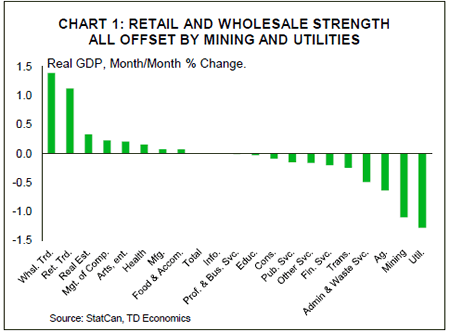
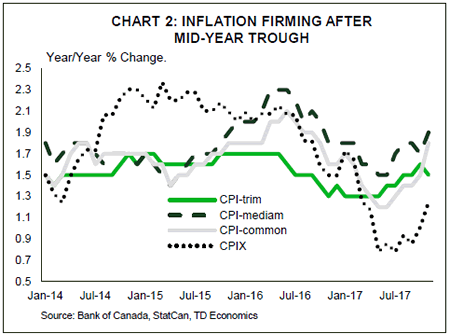
U.S.: Upcoming Key Economic Releases
U.S. Employment – December
Release Date: January 5, 2018
Previous Result: 228k, unemployment rate: 4.1%
TD Forecast: 170k, unemployment rate: 4.1%
Consensus: 185k, unemployment rate: 4.0%
We expect nonfarm payrolls to moderate to a 170k in December after two consecutive gains north of 200k. Moreover, payrolls are likely to give back some of its previous strength and slow to its current trend, at this stage of the cycle. The current trend in payrolls is running near 175k.
We expect the unemployment rate to remain at 4.1% for the third month with risks skewed to the downside amid robust employment growth. We expect to see a stronger 0.3% m/m print on average hourly earnings, which disappointed in the prior two months. Calendar effects are also in our favor this month, such that a sharper gain cannot be excluded. Still, the y/y pace will be held down by base effects, and our forecast suggests an unchanged 2.5% rate.
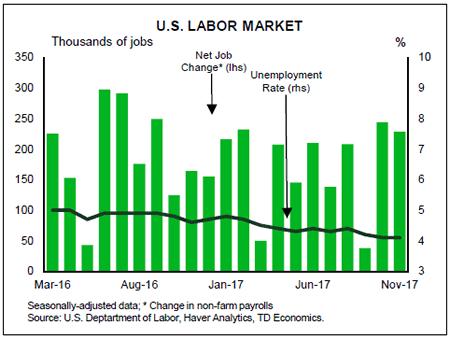
Canada: Upcoming Key Economic Releases
Canadian Employment – December
Release Date: January 5, 2018
Previous Result: 79.5k, unemployment rate: 5.9%
TD Forecast: -10k, unemployment rate: 6.0%
Consensus: N/A
The labour market is set to end 2017 on a weak note with the loss of 10k jobs, though this can hardly be viewed as overly negative after the hiring surge in November. Job losses should be felt in both goods and services as retail and manufacturing give back some of the +30k jobs each industry added in November. However, given the mature phase of the labour market it is likely that headline job growth is overlooked in favour of measures of labour market slack. Here we expect a further improvement in wage growth for permanent employees, with 2.8% y/y likely, though the unemployment rate will likely rebound to 6.0%.
